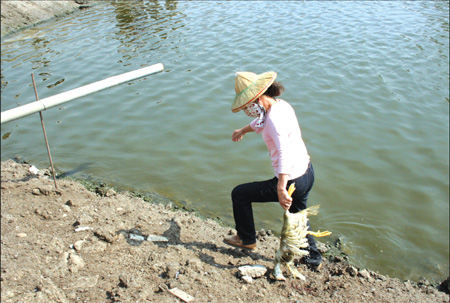Contamination prompts county to cull 10,000 ducks
Updated: 2009-11-13 08:39
(HK Edition)
|
|||||||
|
A worker recovers a dead duck from a pond inside the contaminated duck farm in Daliao township of Kaohsiung County, southern Taiwan yesterday. CNA |
KAOHSIUNG: A county bordering this southern port, Taiwan's second largest city, has been found to have numerous sites contaminated with toxic chemicals from steel slag dumped there, it was revealed yesterday, after the authorities slaughtered nearly 10,000 ducks at the first contaminated site discovered.
The ducks in Daliao township in Kaohsiung County were slaughtered early Wednesday after the Environmental Protection Administration (EPA) confirmed that they contained levels of copper, nickel, chromium, zinc, arsenic and lead that were two to 10 times safety limits.
The duck farm, which covers an area of about 1 hectare and is surrounded by barbed wire fence, was reportedly a landfill illegally filled with dumped steel mill slag.
According to Taiwan's laws, steel furnace slag is permitted to be used for land fill or road paving, but not for farmland fill.
There were fears that some of the contaminated ducks from the farm have been sold to and eaten by consumers.
The farm operator told reporters yesterday that he rented the land from a company 10 years ago, but only began raising ducks there after Typhoon Morakot hit Taiwan in early August and that "not a single duck was sold because they were all killed" in the typhoon.
But Huang Huan-chang, an environmental activist and the organizer of an environmental protection program at Tainan Community University, told reporters that the duck farm had been in operation since 2006 and provided photos as evidence. He speculated that dioxin-contaminated ducks had already been sold to consumers.
Huang, who tipped off the government about the contaminated duck farm also revealed yesterday that there are six other contaminated sites in the county.
The findings have prompted the Environmental Protection Administration to launch an investigation yesterday.
The total of seven contaminated zones include Hunghsiashan, Dapinding and Luotuoshan, which were filled by dumped steel slag that contain heavy metal compounds two times above safety limits, said Huang.
The other sites, which are contaminated with heavy metal components, are currently still being used to grow pineapples and other crops, Huang added.
At the center of the contaminated areas is Fengshan Reservoir, which holds up to 8.7 million tons of water to meet the needs for industrial and household use in the greater Kaohsiung area. A thorough inspection will be needed to determine whether the reservoir is polluted, according to Huang.
Yesterday, the Environmental Protection Administration took pond-raised tilapia (a genus of African fishes introduced into lakes and ponds to control algae growth) from the duck farm in an attempt to determine the source of the dioxin in the area. The results will be available in a week.
However, the EPA has already found that the amount of dioxin in the soil under the pond was 23.2 pico-grams per gram of fat, which is 11 times in excess of the EPA standard.
As the duck farm operator had not registered for a license to run the farm as stipulated in the Animal Industry Act, he could face a fine ranging from NT$30,000 to NT$150,000, according to the county government.
China Daily/CNA
(HK Edition 11/13/2009 page2)
